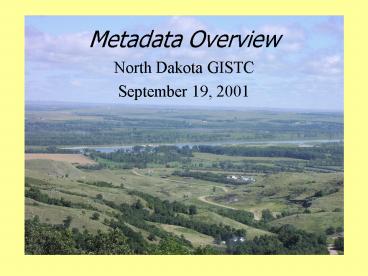Metadata Overview - PowerPoint PPT Presentation
1 / 34
Title:
Metadata Overview
Description:
FITNESS FOR USE -- data needed to determine if a set of data meets a specific need. ... To provide information to data catalogs and clearinghouses. ... – PowerPoint PPT presentation
Number of Views:51
Avg rating:3.0/5.0
Title: Metadata Overview
1
Metadata Overview
- North Dakota GISTC
- September 19, 2001
2
What is Metadata?
- Describes the content, quality, condition, and
other characteristics of data. - Helps a person to locate and understand data.
- (from http//biology.usgs.gov/fgdc.metadata/versio
n2/metadata2.htm)
3
What is Metadata?
- Includes information needed to
- determine the sets of data that exist for a
geographic location - determine if a set of data meets a specific need
- acquire an identified set of data
- process and use a set of data.
- (from http//biology.usgs.gov/fgdc.metadata/versio
n2/metadata2.htm)
4
Put another way metadata provide
- AVAILABILITY -- data needed to determine the sets
of data that exist for a geographic location. - FITNESS FOR USE -- data needed to determine if a
set of data meets a specific need. - ACCESS -- data needed to acquire an identified
set of data. - TRANSFER -- data needed to process and use a set
of data. - (from http//biology.usgs.gov/fgdc.metadata/versio
n2/metadata2.htm)
5
Uses of Metadata
- To organize and maintain an organizations
investment in data. - To provide information to data catalogs and
clearinghouses. - To provide information needed to process and
interpret data to be received through data
transfer from an external source - (from http//biology.usgs.gov/fgdc.metadata/versio
n2/metadata2.htm)
6
Metadata Standards
- If metadata is to be used to describe, organize,
and access spatial data, standards need to be
established. - These standards can range from none, through
local standards, to global standards.
7
Objectives of a Standard
- Provide a common set of terminology and
definitions for the documentation of digital
geospatial data. - Establish the names of data elements and compound
elements (groups of data elements) to be used for
these purposes, the definitions of these compound
elements and data elements, and information about
the values that are to be provided for the data
elements. - (from http//biology.usgs.gov/fgdc.metadata/versio
n2/metadata2.htm)
8
Metadata Standards
- Most standards have elements of the Content
Standard for Digital Geospatial Metadata (CSDGM)
developed by the Federal Geographic Data
Committee (FGDC). - In this presentation, the CSDGM will be referred
to as the FGDC standard.
9
Who Sets Metadata Standards?
The Federal Geographic Data Committee (FGDC)
coordinates the development of the National
Spatial Data Infrastructure (NSDI). The NSDI
encompasses policies, standards, and procedures
for organizations to cooperatively produce and
share geographic data. The 17 federal agencies
that make up the FGDC are developing the NSDI in
cooperation with organizations from state, local
and tribal governments, the academic community,
and the private sector. (from http//www.fgdc.gov/
)
10
Metadata Scope
- Executive Order 12906, "Coordinating Geographic
Data Acquisition and Access The National Spatial
Data Infrastructure," (NSDI) was signed on April
11, 1994, by President William Clinton. - In addition to use by the Federal Government, the
FGDC invites and encourages organizations and
persons from State, local, and tribal
governments, the private sector, and non-profit
organizations to use the standard to document
their geospatial data. - (from http//www.fgdc.gov/metadata/contstan.html)
11
Contents of Metadata
- The FGDC standard is composed of seven sections.
- Each section describes a different component of
the standard - To meet minimum FGDC compliancy, one must use at
least Sections 1 and 7.
12
FGDC Sections
(http//biology.usgs.gov/fgdc.metadata/version2/)
13
Section 1
(http//biology.usgs.gov/fgdc.metadata/version2/)
14
Section 2
(http//biology.usgs.gov/fgdc.metadata/version2/)
15
Section 3
(http//biology.usgs.gov/fgdc.metadata/version2/)
16
Section 4
(http//biology.usgs.gov/fgdc.metadata/version2/)
17
Section 5
(http//biology.usgs.gov/fgdc.metadata/version2/)
18
Section 6
(http//biology.usgs.gov/fgdc.metadata/version2/)
19
Section 7
(http//biology.usgs.gov/fgdc.metadata/version2/)
20
What Does It Look Like?
- Metadata can be exported to a variety of file
formats for viewing or inclusion with GIS data. - For example, using ArcCatalog, the metadata can
be saved to an HTML file and then viewed.
21
Metadata Storage
- Metadata can be stored as a separate file in
various formats or in a database. - Using ArcCatalog, the metadata is stored as XML
data, in a file or in a geodatabase. - With XML, stylesheets can be defined to how the
data is to be presented, e.g., ESRI format or
FGDC format, even ND format.
22
Metadata Viewing
- There are several non-ESRI tools for creating and
editing metadata. - The ESRI ArcCatalog tool can be used to view,
create, and edit metadata. - The next few slides will show some of the viewing
options in ArcCatalog.
23
Viewing metadata
24
FGDC format
25
ESRI format
26
Metadata Creation Editing
- The next few slides will point out the creation
and editing tools of ArcCatalog.
27
Create/Update
28
Edit
29
The Seven Sections
30
Metadata Challenges forNorth Dakota
- Data entry speed how much time will it take to
enter the data, will people avoid loading data
onto the hub? - Inventory of current metadata that we already
have and its application. - Deciding on our standard.
31
Metadata Benefits forNorth Dakota
- Lends credibility to our GIS data repository
initiative shows that we are serious with our
effort. - Leverage the benefits previously discussed, e.g.,
maintain investment in data. - Funding opportunities from FGDC. 1mm allocated
for 2001.
32
Recommendations
- Begin discussions now of what GISTC want in our
standards, e.g., make it our goal to implement
Sections 1 and 7 as the minimum standard. - Discuss the creation/editing tools GISTC wish to
use. - Assign responsibilities as needed, key e.g., key
contacts for each agency.
33
Useful Links
- Graphical FGDC standards http//biology.usgs.gov/
fgdc.metadata/version2/ - Printed FGDC standards http//www.fgdc.gov/stand
ards/documents/standards/metadata/v2_0698.pdf - Metadata editor tools (one of several listings)
http//wisclinc.state.wi.us/metadata/mtools.html - Ten most common metadata errors
http//www.fgdc.gov/metadata/top10metadataerrors.p
df - Metadata primer on implementation
http//www.lic.wisc.edu/metadata/metaprim.htm
34
Wrap-upandDiscussion
http//geography.miningco.com/library/maps/blusnd.
htm
North Dakota 1895































